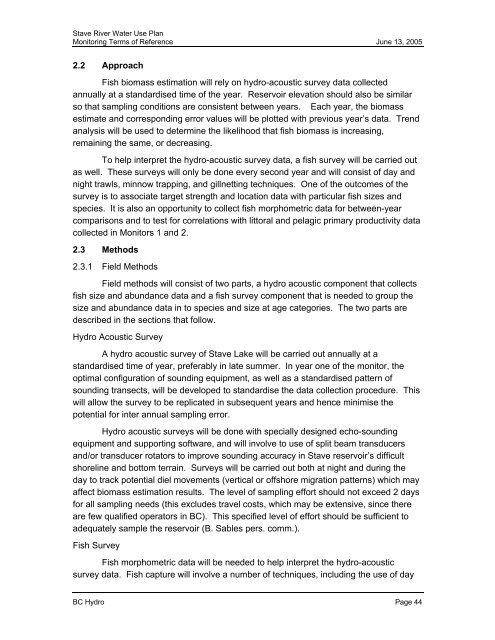Stave River Water Use Plan - BC Hydro
Stave River Water Use Plan - BC Hydro
Stave River Water Use Plan - BC Hydro
Create successful ePaper yourself
Turn your PDF publications into a flip-book with our unique Google optimized e-Paper software.
<strong>Stave</strong> <strong>River</strong> <strong>Water</strong> <strong>Use</strong> <strong>Plan</strong><br />
Monitoring Terms of Reference June 13, 2005<br />
2.2 Approach<br />
Fish biomass estimation will rely on hydro-acoustic survey data collected<br />
annually at a standardised time of the year. Reservoir elevation should also be similar<br />
so that sampling conditions are consistent between years. Each year, the biomass<br />
estimate and corresponding error values will be plotted with previous year’s data. Trend<br />
analysis will be used to determine the likelihood that fish biomass is increasing,<br />
remaining the same, or decreasing.<br />
To help interpret the hydro-acoustic survey data, a fish survey will be carried out<br />
as well. These surveys will only be done every second year and will consist of day and<br />
night trawls, minnow trapping, and gillnetting techniques. One of the outcomes of the<br />
survey is to associate target strength and location data with particular fish sizes and<br />
species. It is also an opportunity to collect fish morphometric data for between-year<br />
comparisons and to test for correlations with littoral and pelagic primary productivity data<br />
collected in Monitors 1 and 2.<br />
2.3 Methods<br />
2.3.1 Field Methods<br />
Field methods will consist of two parts, a hydro acoustic component that collects<br />
fish size and abundance data and a fish survey component that is needed to group the<br />
size and abundance data in to species and size at age categories. The two parts are<br />
described in the sections that follow.<br />
<strong>Hydro</strong> Acoustic Survey<br />
A hydro acoustic survey of <strong>Stave</strong> Lake will be carried out annually at a<br />
standardised time of year, preferably in late summer. In year one of the monitor, the<br />
optimal configuration of sounding equipment, as well as a standardised pattern of<br />
sounding transects, will be developed to standardise the data collection procedure. This<br />
will allow the survey to be replicated in subsequent years and hence minimise the<br />
potential for inter annual sampling error.<br />
<strong>Hydro</strong> acoustic surveys will be done with specially designed echo-sounding<br />
equipment and supporting software, and will involve to use of split beam transducers<br />
and/or transducer rotators to improve sounding accuracy in <strong>Stave</strong> reservoir’s difficult<br />
shoreline and bottom terrain. Surveys will be carried out both at night and during the<br />
day to track potential diel movements (vertical or offshore migration patterns) which may<br />
affect biomass estimation results. The level of sampling effort should not exceed 2 days<br />
for all sampling needs (this excludes travel costs, which may be extensive, since there<br />
are few qualified operators in <strong>BC</strong>). This specified level of effort should be sufficient to<br />
adequately sample the reservoir (B. Sables pers. comm.).<br />
Fish Survey<br />
Fish morphometric data will be needed to help interpret the hydro-acoustic<br />
survey data. Fish capture will involve a number of techniques, including the use of day<br />
<strong>BC</strong> <strong>Hydro</strong> Page 44
















